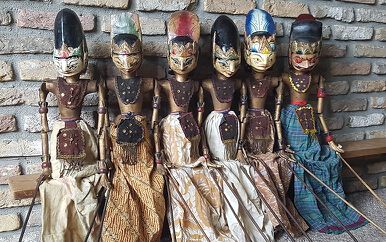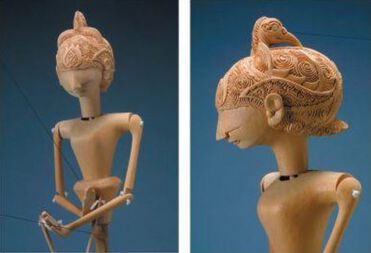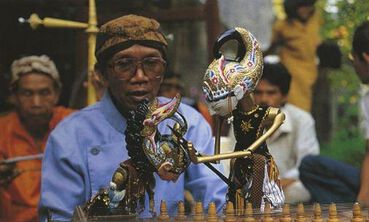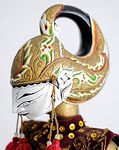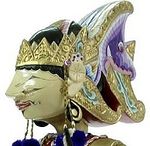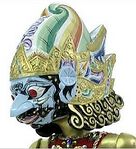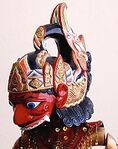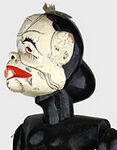Wayang Golek Puppets
To create a new page, enter a unique page name below.
If a page with that name already exists, you will be sent to a form to edit that page.
For existing pages ... see category Wayang Golek Puppets.
Fill in the form with the details of your image and save the page.
Wayang Golek - Cultural Context and History:
Indonesia has a vast and rich history of puppetry. In fact, there are many different styles of puppetry from Indonesia. One of the most popular is Wayang Golek (rod puppets). Wayang means puppet, Golek means rod (as the puppets are operated by wooden rods), therefore, Wayang Golek means Rod Puppets.
Wayang Purwa: the so-called 'old' wayang, the Mahabharata and Ramayana, have their origins in India and are more than 2000 years old and have a Hindu character. The Mahabharata is the story of the battle between the enemy cousins the Pandawa and the Korawa. The Pandawa, the five brothers Yudistira, Bima, Arjuna and the twins Nakula and Sadewa, inherit the throne from their father Pandu. The Korawas dispute this right because their blind father Dasarata temporarily ceded his throne to Pandu, the Pandawa's father. In a game of dice, the eldest Pandawa gives up his rights to the throne to the Korawas. Rivalries arise, eventually leading to the expulsion of the Pandawa. After finding powerful allies, including Prince Kresna, they try to regain their rights to the empire. A major battle ensues, in which all hundred Korawa and the Pandawa ultimately die. In the end, Parikesit, the grandson of Arjuna, is the only one left standing on the battlefield. All Javanese princes are directly descended from him.
Occasions for performing wayang is 'cleansed'. Ruwat performances that are given when evil in children must be renounced. This is, for example, the case with an unfavorable number of children or with a certain ratio of boys and girls in the family.
A wayang performance follows a fixed sequence of scenes:
1. A laudatory description of the first empire. The main characters are performed in a royal palace or in the abode of the gods (depending on the lakon).
2. The king and his ministers have gathered to solve a certain problem in the kingdom: a troubled marriage, repelling an enemy attack, the kidnapping of a child, etc.
3. In this scene the story moves to the kingdom of the enemies. The enemy king discusses his problems with his entourage, decides what to do and goes to war.
4. A first battle takes place in a forest to clarify which people are fighting for which party. There are no deaths in this battle and it always ends in a draw. Figures positioned to the right of the puppeteer belong to the 'good' party and figures positioned to the left belong to the 'bad' party.
5. The hero of the story rises around midnight. He holds his own in the ensuing battles, errors and intrigues.
6. The greatest battle of the lakon takes place, which always ends with the victory of the good side.
7. A closing party takes place in the good king's palace.
Materials and Construction:
- Three-dimensional Indonesian puppets are carved out of light, softwood.
- The head of the puppet is the most important part, and that is the most intricately carved section of each puppet.
- The puppeteer will often carve the face of a bird into the back of the puppet's headdress.
- Once the head is carved, the waist and torso are then carved.
- After the head and torso have been created, a hole is drilled from the neck to the bottom of the trunk where a large wooden rod is placed.
- The head is then mounted on the top of the wooden rod.
- The arms are then carved into two sections: shoulder to elbow, and hand to elbow.
Performance Style:
- Wayang Golek performances take place on special events: weddings, religious ceremonies or cultural days.
- Performances usually begin at 9:30pm and last until 4:30am in the morning.
- A puppet troupe may be hired by an individual, a family or an entire village for a particular special day. A puppet troupe can consist of up to 30 people who are all directed by the dalang.
- The dalang is the puppet master that organizes the entire troupe: he is referred to as a master musician, an epic storyteller, a comic wonder and even a deep philosopher. Some dalangs even have the power to perform exorcisms! Dalang's are also similar to a spiritual guide: they tell epic tales about gods and goddesses and other spiritual beings: they are similar to a priest, a reverend or any other type of religious leader. A Wayang Golek Dalang operates puppets in front of a crowd.
- The Dalang sits on a raised platform in the centre of a crown of people. He can operate several puppets at once by using an ingenious device called: the banana log. The banana log is a long, rectangular and has several holes drilled into it. It is used to stabilize puppets so that the Dalang can operate more than one puppet at the same time.
Interesting Facts:
- Puppet training begins usually at the age of 10-12, and the young puppeteer often trains with a relative.
- The 'apprentice' dalang is called the 'catrik' which means 'disciple'.
There are five different types of characters in Wayang Golek Puppetry:
- Refined Characters: These characters have white faces, bowed heads, and small and downcast eyes. They move in slow, gliding motions and speak in low, melodious voices. Their language is polite, and the thoughts they express are complex. Heroes and heroines are usually of this type.
- Semi refined Characters: These characters have white or pink faces, slightly more upright heads, and small eyes that gaze straight forward. They move in quick but measured steps and speak in high-pitched voices. While generally refined, these characters are a bit more direct than the purely refined characters and more inclined toward precipitous actions.
- Strong Characters: These characters usually have faces of deep pink, blue, or other dark colors, and large, bulging eyes. Their heads are bowed if they are modest or held high if they are boastful. The bodies of these puppets are larger than those of the previous groups. Their voices are deep and gravelly. The puppeteer creates the sound by tightening his vocal chords and resonating the voice in his chest cavity. These characters are the worker bees of the wayang world. If there is a battle to be fought, a forest to be cut, or a bridge to be built, the strong characters are ready.
- Emotionally Uncontrolled Characters: These characters have red or dark-colored faces, protruding eyes, and open mouths with visible fangs. They hold their heads high and have large bodies. They speak in piercing voices with a musical lilt. These characters are the antagonists. (the bad guy who opposes the hero of the story.
- Special Characters: Finally, there are special characters—those that do not fall into the other categories. Their voices and characteristics must be learned individually. There are perhaps fifteen characters in this category; many of them jesters.The most important jester is Semar, who has a white face and a black body. He is actually a high god who has descended to earth to help humankind. He is both male and female, and is both father and mother to his sons. He is always groaning about how his sons do not pay attention to the important things that are happening around them. He loves them dearly but reprimands them regularly. His voice is slow and sometimes whiny.
More info:
About Wayang Golek
Wayang Golek performance
